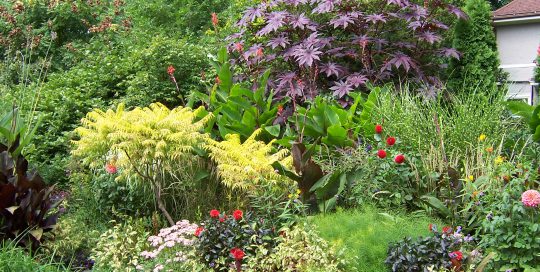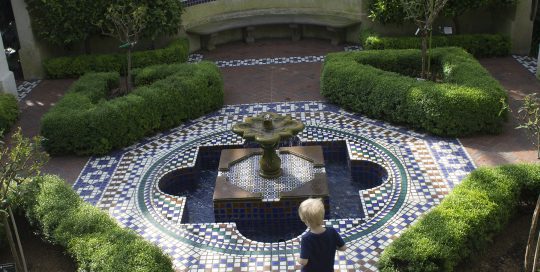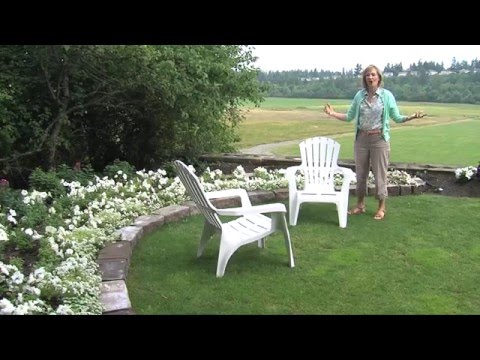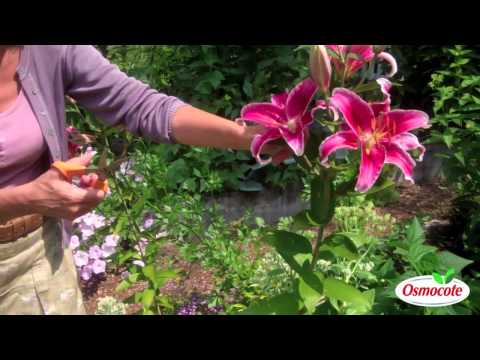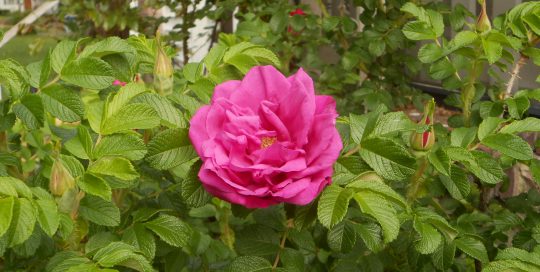What do carpet beds, moon gardens, cottage gardens, specimen trees, snowball bushes and fragrant peonies have in common? They are all part of the tapestry that made up the Victorian-era garden in America. This article provides a brief history of the key ideas that dominated that period and of their continued impact on the garden designs of today.
The Golden Age of Horticulture
Hi, my name is Nina Koziol. I love to collect old gardening books, seed catalogs, garden-themed post cards and photographs, particularly those that date from 1870 to 1900. They provide a fascinating glimpse at the flowers, vegetables and garden design ideas of that era, many of which are still relevant today. This period is sometimes referred to as the Golden Age of Horticulture. It was a time when plant explorers introduced new and exotic annuals, perennials, shrubs, trees and vines into the marketplace. Hybridizers began creating new plants that offered larger flowers and double blossoms, as well as unusual bi-colored flowers.
The Introduction of the Lawnmower
In 1870,the American market introduced the lawnmower. Frank Scott published “The Art of Beautifying Suburban Home Grounds,” which contained garden designs that homeowners could adopt. The black-and-white drawings showed various houses and grounds sprinkled with trees, shrubs and planting beds. There were a series of dotted lines — sight lines — from the “windows” across a wide expanse of lawn. Scott focused on something that is often overlooked today — the importance of sight lines from the windows in our houses into our gardens. The view you see from inside your home is just as important as how your landscape looks to a passersby. Scott liked the idea of looking out windows into the front and side yards and seeing a nicely mown lawn dotted with unusual flowering trees and shrubs, evergreens, and in some designs, a sweeping curved bed of perennials.
Carpet Beds
The lawnmower created a carpet of green upon which wealthy homeowners could create carpet beds—flower beds filled with hundreds and sometimes thousands of annuals in very elaborate designs. The designs ranged from fleur-de-lis and stars to floral “clocks,” ribbons, geometric patterns, and even names spelled out with flowers. Some municipal park districts and Disney’s Epcot Theme Park at Orlando, Florida, still use elaborate carpet bedding schemes in their landscapes.
Among the many popular flowers used in Victorian carpet beds were marigolds, celosia, silvery leaved dusty miller, asters, poppies, ageratum, pansies and geraniums. Chinese silver grass (Miscanthus) and fountain grass (Pennisetum) — two grasses available today, began appearing in catalogs and magazines in the 1890’s along with Rugosa roses, hostas and canna lilies.
Scott recommended placing fragrant shrubs like viburnum, lilac and flowering almond around the foundation of houses. Up until the Civil War, most homeowners had very little foundation planting. That’s because physicians thought that placing plants too close to the house would create damp, unhealthy conditions that would lead to consumption (tuberculosis). That thinking changed as the economy grew and big houses were built with tall stone foundations. In fact, fragrant shrubs were thought to soften the stonework and allow the fragrance to drift indoors on warm summer days.
The Path to the Front Door
The path to the front door became wider as well. Scott recommended a 4- to 5-foot wide path with a 2-foot-wide border of annuals on each side. The wide path would allow a couple to walk side-by-side and the woman’s ankle-length dress would not brush against the flowers. A wide, welcoming path to the front entry is still the mark of a good design.
The Snowball Bush
The Victorians were also fond of “specimen” trees — unusual or impressive plants grown as a focus of interest. Specimen trees could have variegated leaves or a weeping form like a willow or red leaves. Victorians especially liked snowballs in summer. The snowball bush is a term often used for hydrangeas (Hydrangea spp.) and viburnums (Viburnum spp.). They share the name snowball bush because of their large, white flower heads, but hydrangeas and viburnums are different.
Cottage Gardens
Like houses, cars and clothes, popular garden designs change with time. As carpet beds began to fade from fashion, cottage gardens filled with annuals, perennials and flowering vines began appearing in paintings, on women’s magazine covers and in seed catalogs. Unlike carpet beds with their strict designs and tightly controlled plantings, cottage gardens were the exact opposite—loose, lush, overflowing and often flamboyant. Some annual flowers self-sowed — the seeds fell into the soil and the plants popped up anywhere, so the result was very informal. Foxgloves, hollyhocks, bellflower, lavender, pinks, daisies and annual vines, such as kiss-me-over-the-garden-gate and morning glories, were staples of the cottage garden.
Fragrance Matters
Fragrance was very important, too. For example, by1900, there were some 250 varieties of sweet peas. Carnations, roses, peonies, sweet alyssum and lilies were star players in the fragrant garden. Some garden designers at the time also touted the making of one-color beds and borders, such as the all-blue garden or the all-red garden of annuals and perennials.
Moon Gardens, Seriously
One of my favorite Victorian theme gardens is the moon garden — a garden that focused on all white flowers. The moon garden might contain fragrant lilies, like Casa Blanca, nicotiana and datura and plants with silver or variegated leaves. As its name suggests, enjoy the moon garden at dusk and into the evening. Moonflower vine (Ipomoea alba) is an annual fast-growing vine with white, fragrant trumpet flowers that unfurl at dusk. They are easy to grow from seed. Next time you’re in your garden at dusk, notice how all the bright colors — the orange, reds and purples fade away while any light-colored or white flowers begin to glow even on a cloudy night. And remember, what’s old is new again.
Lessons from the Victorian Garden Era
- Make the main path to your front door at least four feet wide if possible. Five feet is even better.
- Create a moon garden with white or pale yellow flowers and silver or variegated foliage near an entryway, deck or patio — somewhere that can be enjoyed in the evening.
- Add some fragrance. Many shrubs, like Judd viburnum, offer snowball-shaped flowers with a scent that can only be described as almond-vanilla.
- Choose embellishments (planters, benches, arbors, fencing material, etc.) in a style, color or material to enhance the architecture of your home. If you have a mid-century contemporary ranch, a Victorian urn is not quite the best fit.
- Evaluate your foundation plantings. Does your house say “1910,” but the foundation planting suggests “1955?” You get the idea.
- Check out the sight lines from your windows. Would a focal point like a sun dial, bird bath or a specimen plant to dress up the view?
- Consider how much time you have for maintenance. Cottage gardens, for example can be extremely high maintenance. You might get a similar effect using more flowering shrubs and future perennials.
Web Resources:
The Garden History Society: http://www.gardenhistorysociety.org/aboutus/links/
Archives of American Gardens: http://sirismm.si.edu/siris/aagtop.htm
Old-House Gardens www.oldhousegardens.com
Daffodils in American Gardens 1733-1940: www.sc.edu/uscpress/books/2015/7401.html

